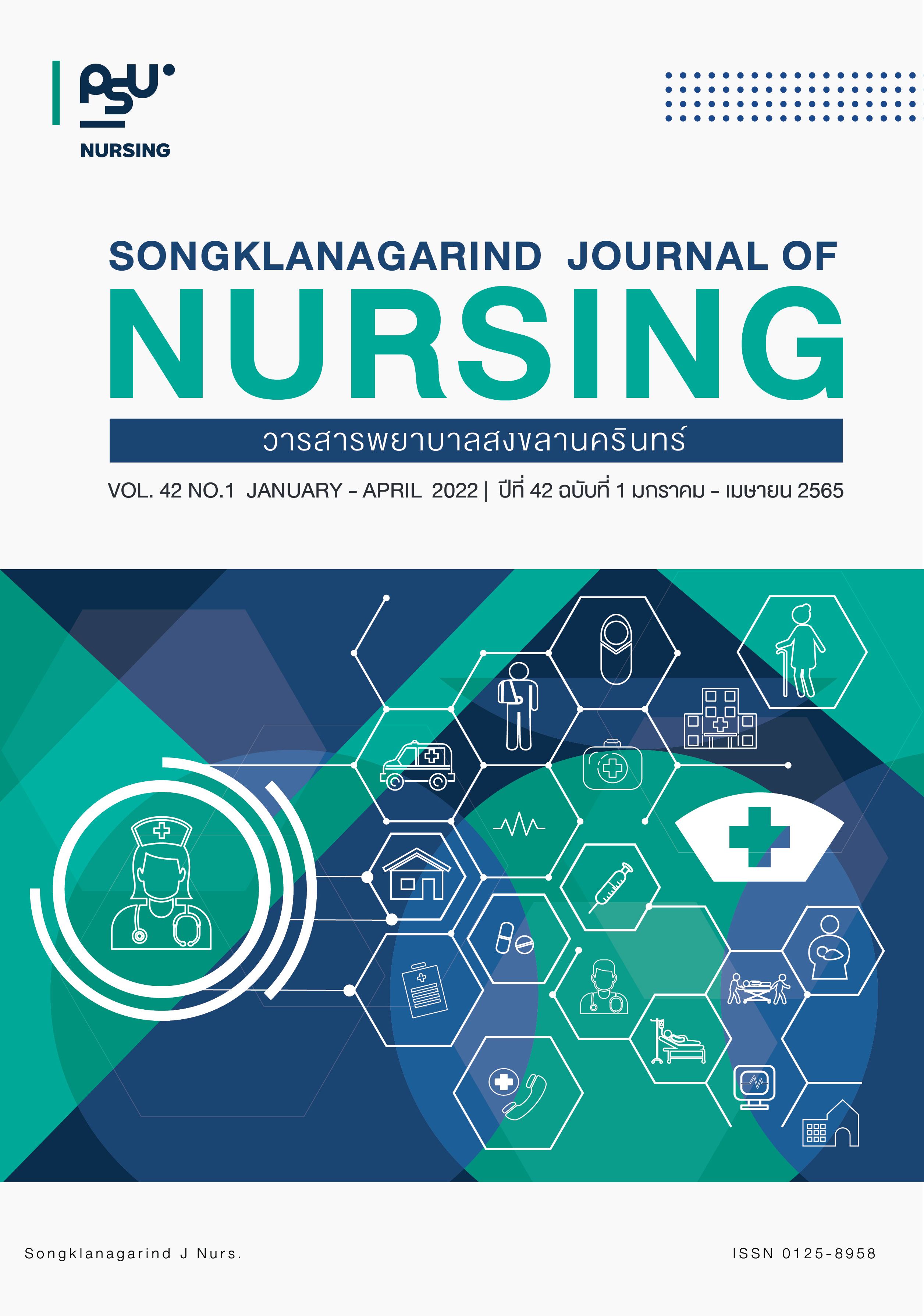Factors Predicting Preeclampsia among Pregnant Women in Sawanpracharak Hospital
Main Article Content
Abstract
Objective: The objective of this study was to investigate the factors predicting preeclampsia among pregnant women in Sawanpracharak Hospital. Methods: A retrospective analytical study was conducted to collect data from the history of pregnant women who delivered at Sawanpracharak Hospital. The sample was selected based on a purposive sampling, divided into two groups, comprising 110 women diagnosed with preeclampsia and 220 women without preeclampsia. Research instruments for data collection were 1) a personal data record form and 2) a record on factors predicting preeclampsia. Data were analyzed using descriptive statistics, Chi-Square, and binary logistic regression analysis. Results: Factors predicting preeclampsia included a 2.83-fold pre-pregnancy body mass index of 25 kg/m2 or higher (95% CI 1.57-5.09), a 5.92-fold increase in higher gestational weight gain in the second trimester than the criteria (95% CI 3.18-11.03), a 5.77-fold mean arterial pressure in the second trimester of 90 mmHg or higher (OR 5.77, 95% CI 3.23-10.32), a 9.19-fold pre-pregnancy underlying diseases (95% CI 2.99-28.23), a 1.69-fold increase among pregnant women aged 30 years old or older (95% CI 1.06-2.70), and a 7.40-fold increase among pregnant women with obstetric history (95% CI 1.51-36.28), respectively with a statistical significance level. Conclusion: The findings indicate that these factors could predict preeclampsia. Therefore, to achieve efficient screening or monitoring of factors predicting preeclampsia, it is imperative to jointly consider these factors.
Article Details

This work is licensed under a Creative Commons Attribution-NonCommercial-NoDerivatives 4.0 International License.
References
American College Obstetricians Gynecologists. Gestational hypertension and preeclampsia. Obstet Gynecol. 2020; 135(6): 237-60. doi: 10.1097/AOG.0000000000003891.
World Health Organization. Recommendations for prevention and treatment of preeclampsia and eclampsia [Internet]. Switzerland: WHO; 2011 [cited 2021 Feb 12]. Available from: https://apps.who.int/iris:/bitstream/handle/10665/44703/9789241548335.
Bureau of Policy and Strategy; Office of Permanent Secretary, Ministry of Public Health. Public health statistics A.D. 2018. Nonthaburi: Ministry of Public Health; 2018. Thai.
The Royal Thai College of Obstetricians and Gynaecologists. Clinical practice guideline summary management of hypertensive disorders in pregnancy [Internet]. [cited 2020 Oct 20]. Available from: http://www.rtcog.or.th/home/wp-content/uploads/2020/10/OB-63-021-Management-of-Hypertensive-Disorders-in-Pregnancy_summary07Oct20.pdf.
Duley L, Henderson-Smart DJ, Meher S. Altered dietary salt for preventing pre-eclampsia, and its complications. Cochrane Database Syst Rev. 2005; 19(4): doi: 10.1002/14651858.CD005548.
Techawathakul S, Ratinthorn A, Yusamran, C, et al. Risk factors related to preeclampsia. J Nurs Sci. 2014; 32(1): 61-70. Thai.
Aksornphusitaphong A, Phupong V. Risk factors of early and late onset pre-eclampsia. J Obstet Gynaecol Res. 2013; 39(3): 627-31. doi: 10.1111/j.1447-0756.2012.02010.x.
Gore AN, Hoffman K, Thomas R, et al. Preeclampsia as an independent risk factor for cardiovascular and metabolic disease [27L]. Obstet Gynecol. 2020; 135(5 Suppl.): 131S. doi: 10.1097/01.AOG.0000664656.72421.7a.
Savitsky LM, Chandrasekaran S, Albright C. Preeclampsia with severe features: Examining the phenotype of disease [28L]. Obstet Gynecol. 2020; 135(5 Suppl): 131S. doi: 10.1097/01.AOG.0000664660.61533.04.
Delivery room in Sawanpracharak Hospital. Annual report 2021. Nakhonsawan: Sawanpracharak Hospital. Thai.
Peng CY, Lee KL, Ingersoll GM. An introduction to logistic regression analysis and reporting. The Journal of Educational Research. 2002; 96(1): 3-14. doi: 10.1080/00220670209598786.
Gisev N, Bell JS, Chen TF. Interrater agreement and interrater reliability: Key concepts, approaches, and applications. RSAP. 2013; 9(3): 330-8. doi: https://doi.org/10.1016/j.sapharm.2012.04.004.
Hinkosa L, Tamene A, Gebeyehu N. Risk factors associated with hypertensive disorders in pregnancy in Nekemte referral hospital, from July 2015 to June 2017, Ethiopia: Casecontrol study. BMC Pregnancy and Childbirth. 2020; 20(16): 2-9. doi: https://doi.org/10.1186/s12884-019-2693-9.
Ye C, Ruan Y, Zou L, et al. The 2011 survey on hypertensive disorders of pregnancy (HDP) in China: prevalence, risk factors, complications, pregnancy and perinatal outcomes. PLoS One. 2014; 9(6): e100180. doi: 10.1371/journal.pone.0100180.
Haugen M, Brantsæter AL, Winkvist A, et al. Associations of pre-pregnancy body mass index and gestational weight gain with pregnancy outcome and postpartum weight retention: A prospective observational cohort study. BMC Pregnancy Childbirth. 2014; 14: 1-11. doi: 10.1186/1471-2393-14-201.
Scheffer KL, Jones R, Holub KS, et al. Complication of pregnancy. In Murray SS., McKinney ES., Holub KS, and Jones R. editors. Foundations of maternal-newborn and women’s health nursing. 7 th ed. St. Louis: Elsevier Mosby; 2019.
Dalmaz CA, Goncalves dos Santon K, Botton MR, et al. Risk factors for hypertensive disorders of pregnancy in Southern Brazil. Rev Assoc Med Bras. 2011; 57(6): 678-82. doi: 10.1590/s0104-42302011000600018.
Suleiman AK. Risk factors on hypertensive disorders among Jordanian pregnant women. Global J of Health Sci. 2014; 6(2): 138-44. doi: 10.5539/gjhs.v6n2p138.
Ayele G, Lemma S, Agedew E. Factors associated with hypertension during pregnancy in Derashie Woreda South Ethiopia, case control. Qual Prim Care. 2016; 24(5): 207-13.
Shao Y, Qiu J, Huang H, et al. Pre-pregnancy BMI, gestational weight gain and risk of preeclampsia: A birth cohort study in Lanzhou, China. BMC Pregnancy and Children. 2017; 17: 400. doi: 10.1186/s12884-017-1567-2.
Hutcheon JA, Stephansson O, Cnattingius S, et al. Pregnancy weight gain before diagnosis and risk of preeclampsia. Hypertension, 2018; 72: 433-41. doi: 10.1161/HYPERTENSIONAHA.118.10999.
Sananpanichkul P. Current insight and ideas about preeclampsia. J Prapokklao Hospital Clinic Medication Educational Center. 2015; 32: 364-76. Thai.
Mayrink J, Souza RT, Feitosa FE, et al. Mean arterial blood pressure: Potential predictive tool for preeclampsia in a cohort of healthy nulliparous pregnant women. BMC Pregnancy and Childbirth. 2019; 19: 460.
Gasse C, Boutin A, Cote M, et al. First-trimester mean arterial blood pressure and the risk of preeclampsia: The real obstetrical syndromes (GOS) study. Pregnancy Hypertensions. 2018; 12: 178-82. doi: 10.1016/j.preghy.2017.11.005.
Luealon P, Phupong V. Risk factors of preeclampsia in Thai women. J Med Assoc Thai. 2010; 93(6): 661-6.
Wei J, Liu CX, Gong TT, et al. Cigarette smoking during pregnancy and preeclampsia risk: A systematic review and meta-analysis of prospective studies. Oncotarget, 2015; 6(41): 43667-78.


